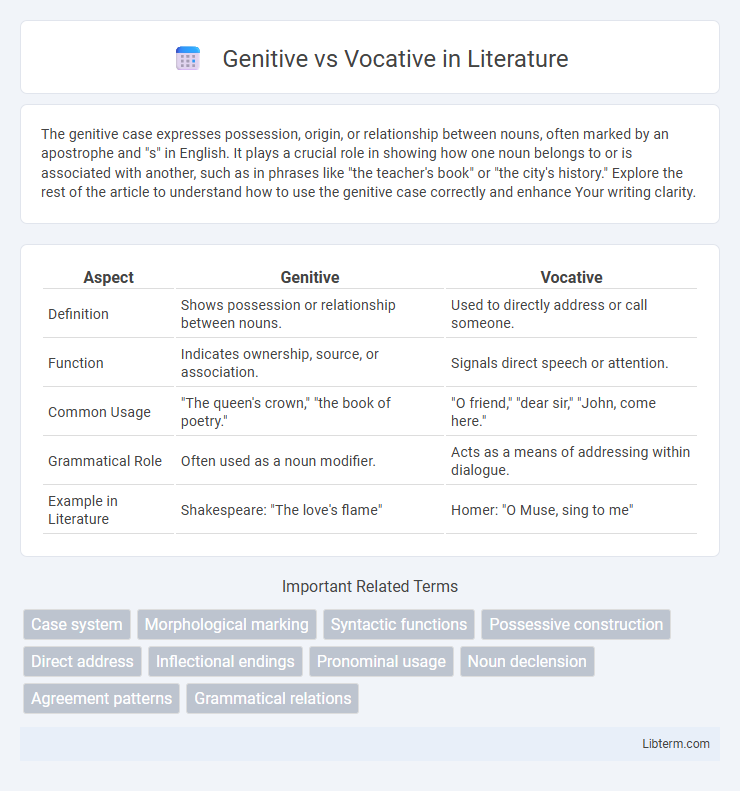The genitive case expresses possession, origin, or relationship between nouns, often marked by an apostrophe and "s" in English. It plays a crucial role in showing how one noun belongs to or is associated with another, such as in phrases like "the teacher's book" or "the city's history." Explore the rest of the article to understand how to use the genitive case correctly and enhance Your writing clarity.
Table of Comparison
| Aspect | Genitive | Vocative |
|---|---|---|
| Definition | Shows possession or relationship between nouns. | Used to directly address or call someone. |
| Function | Indicates ownership, source, or association. | Signals direct speech or attention. |
| Common Usage | "The queen's crown," "the book of poetry." | "O friend," "dear sir," "John, come here." |
| Grammatical Role | Often used as a noun modifier. | Acts as a means of addressing within dialogue. |
| Example in Literature | Shakespeare: "The love's flame" | Homer: "O Muse, sing to me" |
Understanding the Genitive Case
The genitive case primarily indicates possession, origin, or relationship between nouns, often translated in English using "of" or an apostrophe-s ('s). It modifies a noun by showing ownership, such as "the book of the teacher" or "the teacher's book," reflecting a close association between the entities. Understanding the genitive case is essential for grasping the structure of many languages, including Latin, German, and Russian, where it affects noun endings and prepositional usage.
Defining the Vocative Case
The vocative case directly addresses or calls out a person or entity, distinguishing it from the genitive case, which indicates possession or relationship. In languages with a vocative, like Latin and Ancient Greek, this case often uses specific endings or forms to signal direct address, such as "Marcus" becoming "Marce" in Latin. Understanding the vocative case is essential for accurately interpreting dialogues, commands, and expressions of invocation within classical texts.
Core Functions of Genitive
The genitive case primarily indicates possession, origin, and association, linking nouns to express relationships such as ownership, part-whole connections, and source identification. Core functions include showing possession (e.g., "the book's cover"), indicating relationships between entities (e.g., "the city's mayor"), and specifying characteristics (e.g., "a man of courage"). Unlike the vocative case, which is used to address or call upon someone directly, the genitive strictly conveys grammatical relationships between nouns.
Key Uses of Vocative
The vocative case primarily serves to address or call upon a person or entity directly, often marked by a distinct form in languages like Latin or Ancient Greek. It is used to capture attention, express emotion, or make a direct appeal, frequently seen in greetings, exclamations, and commands. Unlike the genitive case, which denotes possession or relation, the vocative emphasizes direct communication with the addressee.
Grammatical Differences: Genitive vs Vocative
The genitive case primarily indicates possession, origin, or association, modifying nouns to show relationships such as "John's book" or "the roof of the house." In contrast, the vocative case is used for direct address, calling or naming someone (e.g., "John, come here!"), often marked by specific forms or intonation but not ownership. Grammatical differences include the genitive's role as a dependent modifier within noun phrases, while the vocative functions independently to capture attention or dialogue interaction.
Examples of Genitive in Sentences
Examples of genitive in sentences illustrate possession or close relationships, such as "The student's book is on the table" and "The color of the sky is beautiful." The genitive case often uses apostrophes in English to show ownership, like "Sarah's car" or "dogs' kennels." In languages with inflected forms, genitive endings modify nouns directly, as in Latin's "libri pueri" meaning "the boy's book.
Examples of Vocative in Sentences
Examples of vocative in sentences highlight direct address, such as "John, can you help me?" or "Ladies and gentlemen, welcome to the event." Vocative cases often use commas to separate the name or title, emphasizing the person being spoken to. Unlike the genitive case, which indicates possession (e.g., "John's book"), the vocative case calls attention to the addressee in conversation or writing.
Common Mistakes with Genitive and Vocative
Common mistakes with the genitive case include confusing possessive forms with contractions or using the genitive where a different case is required, leading to errors in indicating ownership or relationships. In the vocative case, errors often arise by omitting the necessary punctuation or intonation that distinguishes direct address, causing ambiguity or misinterpretation of the sentence. Clear understanding of genitive forms for possession and distinct vocative punctuation is essential for accurate grammar and effective communication.
Tips for Mastering Genitive and Vocative
Mastering the genitive case requires understanding its role in showing possession, relationships, and origin, often marked by apostrophes ('s) in English or specific endings in other languages. The vocative case is used for direct address and often involves distinct punctuation, such as commas, to set off the noun or pronoun being spoken to. Practice identifying and using genitive forms to express ownership clearly, while employing vocative cases to create natural, engaging dialogue or commands in speech or writing.
Genitive and Vocative in Different Languages
The genitive case primarily indicates possession or relationship, evident in languages like Latin, Russian, and German, where nouns change form to express ownership or association; for example, Latin "dominus" (lord) becomes "domini" in genitive to signify "of the lord." The vocative case is used for direct address, often marked distinctly in Classical Latin (e.g., "Marcus" becomes "Marce") but less prominently in modern languages such as English, where it relies on intonation rather than morphological change. Differences in these cases highlight unique syntactic and morphological systems: Slavic languages like Russian use the genitive for negation and quantity expressions, while Classical Latin's vocative maintains a specialized form strictly for calling or addressing someone directly.
Genitive Infographic

 libterm.com
libterm.com